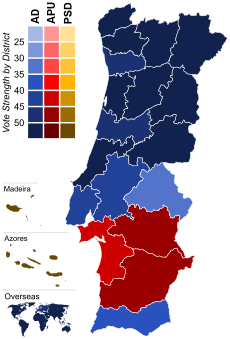| |||||||||||||||||||||||||||||||||||||||||||||||||||||
250 seats to the Portuguese Assembly 125 seats needed for a majority | |||||||||||||||||||||||||||||||||||||||||||||||||||||
|---|---|---|---|---|---|---|---|---|---|---|---|---|---|---|---|---|---|---|---|---|---|---|---|---|---|---|---|---|---|---|---|---|---|---|---|---|---|---|---|---|---|---|---|---|---|---|---|---|---|---|---|---|---|
| Registered | 7,179,023 | ||||||||||||||||||||||||||||||||||||||||||||||||||||
| Turnout | 6,026,395 (83.9%) | ||||||||||||||||||||||||||||||||||||||||||||||||||||
| |||||||||||||||||||||||||||||||||||||||||||||||||||||
| |||||||||||||||||||||||||||||||||||||||||||||||||||||
The 1980 Portuguese legislative election took place on 5 October. The election renewed all 250 members of the Assembly of the Republic.
In January 1980, the Democratic Alliance, which had won the previous election, on 2 December 1979, entered office with Francisco Sá Carneiro leading the government. However, this election was an extraordinary election and because of Fixed-term Parliament rules, in 1980, another election was held.
The Democratic Alliance (AD) won, again, and increased the majority they had achieved 10 months before, in December 1979. The AD won almost 48 percent of the votes and gathered 134 seats, six more.[1] The Socialist Party (PS), now leading a broad coalition called Republican and Socialist Front, got basically the same vote share and seats as in 1979. The Communist led alliance, United People Alliance (APU) lost some ground, gathering almost 17 percent of the votes, 2 percentage points lower than 10 months earlier.
Turnout was one of the highest ever, almost 84 percent, and in terms of ballots cast, the more than 6 million votes cast was a record in Portuguese elections for 44 years after being surpassed in the 2024 legislative election.
Cite error: There are <ref group=lower-alpha> tags or {{efn}} templates on this page, but the references will not show without a {{reflist|group=lower-alpha}} template or {{notelist}} template (see the help page).
- ^ "Vitória de Sá Carneiro nas eleições de 1980 ", RTP, 8 September 2015. Retrieved 9 June 2022.




